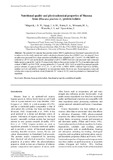| dc.contributor.author | Mugendi, Beatrice J. | |
| dc.contributor.author | Njagi, E.N.M. | |
| dc.contributor.author | Kuria, E.N. | |
| dc.contributor.author | Mwasaru, M. | |
| dc.date.accessioned | 2017-07-03T08:34:12Z | |
| dc.date.available | 2017-07-03T08:34:12Z | |
| dc.date.issued | 2010 | |
| dc.identifier.uri | http://hdl.handle.net/123456789/2742 | |
| dc.identifier.uri | https://www.researchgate.net/publication/285947120_Nutritional_quality_and_physicochemical_properties_of_Mucuna_bean_Mucuna_pruriens_L_protein_isolates | |
| dc.identifier.uri | https://ir-library.ku.ac.ke/handle/123456789/5573 | |
| dc.description.abstract | The potential for mucuna bean protein isolate (MBPI) application as functional ingredient in foods is unknown. In this study nutritional quality and physicochemical properties of MBPI were investigated. Bean samples were processed for L-dopa extraction in distilled water adjusted to pH 3.2 at 60°C for 48hr. MBPI was extracted at pH 9.0 and isoelectrically precipitated at pH 4.5. MBPI from raw and processed seed contained
higher protein content (86.7 and 86.9% respectively) than soybean protein isolate (82.7%). Essential amino acids content of MBPI met FAO/WHO scoring pattern for 2-5 year-old. SDS-PAGE revealed four main polypeptide protein subunits of apparent MW of 11, 19, 36 and 98 kD in MBPI. MBPI exhibited high foam stability, emulsion activity and stability compared to soybean protein isolate. However, poor foam expansion, water and
oil absorption capacity and dark colour (Hunter lab “L” value of 36.39) limits its potential as a functional food ingredient. | en_US |
| dc.language.iso | en | en_US |
| dc.title | Nutritional quality and physicochemical properties of Mucuna bean (Mucuna pruriens L.) protein isolates | en_US |
| dc.type | Article | en_US |

